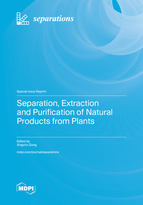Separation, Extraction and Purification of Natural Products from Plants
A special issue of Separations (ISSN 2297-8739). This special issue belongs to the section "Analysis of Natural Products and Pharmaceuticals".
Deadline for manuscript submissions: closed (20 November 2022) | Viewed by 26984
Special Issue Editor
2. Jinhua Institute of Zhejiang University, Jinhua 321016, China
Interests: traditional Chinese medicine quality control; pharmaceutical engineering
Special Issues, Collections and Topics in MDPI journals
Special Issue Information
Dear Colleagues,
Natural products include a large and diverse group of substances from various natural sources such as plants, bacteria, fungi, insects, arachnids, marine organisms and higher-order animals. Natural products have a long history of use as drugs, drug precursors and/or complementary health adjuvants. Most Chinese medicines and other traditional medicines are natural products.
Natural products are usually prepared through a series of processes such as extraction, precipitation and adsorption. Traditional natural product extraction and isolation techniques are time-consuming and expensive. It is particularly important to develop and improve the separation and extraction technology of natural products.
This Special Issue "Separation, Extraction and Purification of Natural Products from Plants" provides an opportunity to publish high-quality multidisciplinary research and reviews related to various aspects of natural product preparation methods, isolation, extraction and purification.
Dr. Xingchu Gong
Guest Editor
Manuscript Submission Information
Manuscripts should be submitted online at www.mdpi.com by registering and logging in to this website. Once you are registered, click here to go to the submission form. Manuscripts can be submitted until the deadline. All submissions that pass pre-check are peer-reviewed. Accepted papers will be published continuously in the journal (as soon as accepted) and will be listed together on the special issue website. Research articles, review articles as well as short communications are invited. For planned papers, a title and short abstract (about 100 words) can be sent to the Editorial Office for announcement on this website.
Submitted manuscripts should not have been published previously, nor be under consideration for publication elsewhere (except conference proceedings papers). All manuscripts are thoroughly refereed through a single-blind peer-review process. A guide for authors and other relevant information for submission of manuscripts is available on the Instructions for Authors page. Separations is an international peer-reviewed open access monthly journal published by MDPI.
Please visit the Instructions for Authors page before submitting a manuscript. The Article Processing Charge (APC) for publication in this open access journal is 2600 CHF (Swiss Francs). Submitted papers should be well formatted and use good English. Authors may use MDPI's English editing service prior to publication or during author revisions.
Keywords
- Chinese medicines
- quality control
- process analytical technology
- quality by design
- separation and purification
- precipitation
- chromatography
- steam distillation
- percolation
- drying






